Original URL: https://www.theregister.com/2013/04/11/antique_code_show_sonic_the_hedgehog/
Sonic the Hedgehog
Sega's spikey blue erinaceinus across platforms, across time
Posted in Personal Tech, 11th April 2013 12:00 GMT
Antique Code Show Pocket-money saved, game ordered, wait for the postman and... nothing. A friend had the game already – rubbing salt into the wound – yet my journey of anticipation home from school each day still arrived at a big hole of spiky blue hedgehog nothingness. The original Sonic the Hedgehog was especially hyped throughout its long development, intensifying this cruel slice of adolescent misery, and when the blessed game did turn up, two weeks late, the cartridge was a dud.
Oh videogame Gods, what had I done wrong? And more importantly, have you punished that grey-importing bastard of a dealer yet?
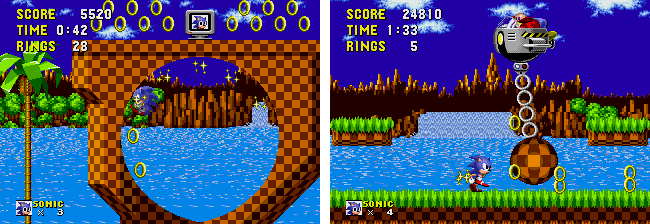
Sonic original: the first in the series
In any case, that first Sonic game was a pivotal moment. Sega had found itself in a bit of a predicament: while it had a great new 16-bit console - the Megadrive; Genesis in the US - with which to take on the might of the all-conquering Nintendo, it had no mascot to drive home sales in the US and European markets.
A crack team of Sega’s best designers - ‘Team Sonic’ - was assembled, and lead game director Hirokazu Yasuhara even put off a transfer to America in order to finish the game. Yes, they pinched Mario’s coins and replaced them with rings, and certainly took a few more sneaky sideways glances at Nintendo’s plumber, but what they came up with was a more arcade-like, spontaneous and immediately gratifying title that, for the time, had kids’ eyes popping out with its multi-coloured, cartoon-like graphics.
One of the Megadrive chipset’s star qualities was its smooth backdrop scrolling. Indeed, parallax scrolling, where numerous background layers move at different speeds, was a common feature of Megadrive titles, creating a strong illusion of movement. Nevertheless, Sonic’s programmers took scrolling to the next level, with scenes flying by at lightning speed – certainly impressive for the time.
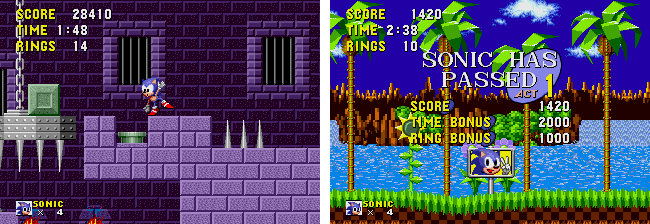
From near death to victory
Ingeniously, Sonic the Hedgehog would regularly allow players to choose their own preferred route, with hidden bonuses and ring collections along the way. Sonic had very simplistic controls: each of the Megadrive’s three buttons would send him into exactly the same jump/spin-attack. Whether this was a deliberate goal for Sega or not, such simplicity helped the title appeal to new and novice gamers, without discouraging more experienced players either.
Power-ups like a protective orb, or temporary invincibility, assisted Sonic en route, and if you could snag a pair of jauntily buckled running boots the extra speed would see Sonic bouncing around levels like a supercharged pinball – opening up sections inaccessible at standard speeds. Fake and breakable walls, springs hidden in trees and secret platforms were all part of the expert Sonic player’s remit.
Bonus levels – “Jump into that giant golden ring, quick!” - saw Sonic racking up points inside a strangely hallucinogenic dream machine. Here you were on the hunt for the elusive ‘chaos emeralds’ – seven in total – which you needed in order to complete the game fully, and beat Dr. Robotnik, Sonic’s slap-head lardy nemesis. This git would turn up periodically in some kind of egg-related death machine, looking like a dodgy perv who locks up small helpless animals for fun. Well, looks weren’t deceiving, since that’s exactly what he had been doing, which explains why cute little bunnies and chipmunks scurry away to freedom every so often. Retro Sega fans might even notice Flicky, the flightless bird, making a cameo appearance after his 1984 arcade outing.
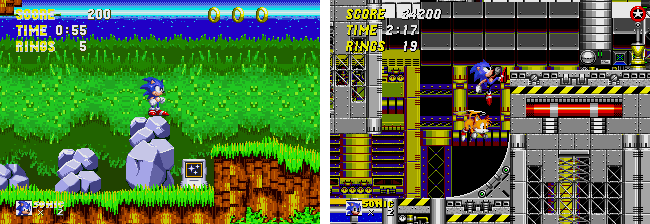
Compare and contrast: Sonic 3, left, Sonic 2, right
Sonic the Hedgehog undoubtedly raised the bar for consumers’ expectations of a home platform game, yet on playing it again, the slap round the face of that “game over” screen really struck me: this title is from the old-school of try, try and try again gaming. Still, those were the times and Sonic was an instant hit; arguably, no home videogame had yet presented such a child-appealing combination of sweetly colourful visuals and glorious pop-audio.
So Sega had its mascot, and cashed in straight away with versions for the 8-bit Master System console – now looking rather long in the tooth – and its portable equivalent, the Game Gear. Knowing the marketable value of its new hero, Sega released upwards of ten more Sonic-related titles for these two pieces of hardware, duly lengthening their lifespans.
For the Megadrive, development of a sequel was taken up by Sega of America, though members of the original team were drafted in to work alongside their yank colleagues. Released simultaneously in Europe and America on “Sonic 2’s day” - yes, a Tuesday - Sonic 2 struck more gold for Sega, sending consoles off the shelves in droves and cementing Sega’s position as a genuine rival to Nintendo.
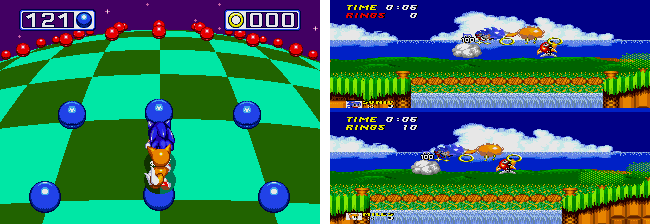
Like the original - only more so
For Sonic’s second outing, Sega wisely retained the majority of game mechanics from the original, though a quirky sonic spin-dash move was added – by pressing ‘down’ on the direction-pad, Sonic could be revved up like a motorbike before spinning off. Sonic’s sidekick, Tails, was also introduced, enabling an enjoyable two-player split-screen race mode. Pseudo-3D bonus levels replaced the hypnosis-inducing stages of the first title, giving a brief hint of what was to come over the next two decades.
Gin and Sonic
Sonic CD came along a year later, attempting to bolster sales of the Mega-CD peripheral. While the hardware it tried to promote was doomed to commercial failure, Sonic CD showed plenty of merit. Again, it stuck to the tried and tested side-scrolling formula, yet introduced a time-travel element - levels could exist in past, present and future - plus the CD-quality soundtrack was an impressive novelty back in 1993. A PC version emerged a few years later, and without doubt the title has aged well, with a re-vamped Sonic CD appearing on modern platforms at the end of 2011.
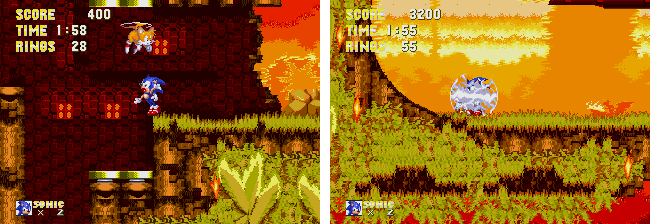
Three's a crowd: Sonic 3 was not the sequel Sega originally planned...
Back on Megadrive cartridge, Sonic the Hedgehog 3 was allegedly going to be a huge – for the time – 34Mb cartridge, yet Sega balked at the cost implications. It opted for a unique piece of game marketing, and released a stripped down Sonic 3, followed six months later by a game called Sonic and Knuckles. While this second installment could be played by itself – and indeed contained the sections culled from the Sonic 3 release – the cartridge itself had a slot onto which any of the previous Sonic games could be piggybacked. Sonic 2 and 3 could then be played using the new character, Knuckles, opening up sections of levels previously unobtainable, due to the echidna’s ability to climb walls and glide through the air. Sonic 1 would launch as a somewhat terrifying standalone collection of its migraine-inducing special stages.
Essentially, that was the end of a very settled and successful era for both Sega and Sonic. In contrast, between the mid-1990s and now, the Sonic franchise has spread out in all sorts of different directions, and unlike Nintendo, which has tended to keep a tight grip on the quality of Mario’s releases, Sega has banged out plenty of tosh along the way.
Sega’s next console effort, the Saturn, was a flop, one reason being that Sega got its knickers in a twist trying to make a decent 3D Sonic game - Sonic X-treme - which after a long and tortuous development cycle was eventually canned. Saturn owners got a spruced-up version of the Megadrive title Sonic 3D – which actually played in isometric 3D – but it wasn’t much consolation. When Sonic R turned up, this attempt at a true 3D racing game on foot, in a similar vein to Mario Kart, was universally panned for its dreadful controls and lack of depth.
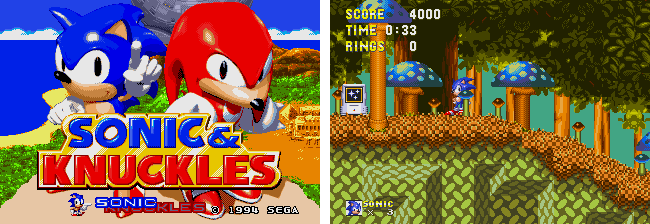
...but was split to form Sonic and Knuckles too
Fast-forward to 2006: a particularly dreadful year. Sonic the Hedgehog for Xbox 360 and PS3 was a scrappy mix of glitches, poor camera angles and unresponsive controls. The year was made even worse by a dreadful port of the original Sonic game to Gameboy Advance – full of disappearing sprites and unresponsive controls.
There have been plenty of spin-offs of variable quality too. Sonic Shuffle (boardgame style title; Dreamcast), Sonic Battle (fighting game; Gameboy Advance) and Sonic Chronicles (RPG; Nintendo DS) have all been interesting distractions, but none have left a significant mark on gaming’s wider history.
Sonic Adventure (1998) and its sequel worked reasonably well, despite a frustrating camera system. Two ‘storybook’ games for the Wii were fairly promising, though the 3D ‘on-rails’ action still wasn’t the most natural of gaming experience. Likewise, 2008’s Sonic Unleashed was let down by trying to be too clever: the night-time levels, where Sonic turns into a “werehog”, involved sluggish, awkward play mechanics.
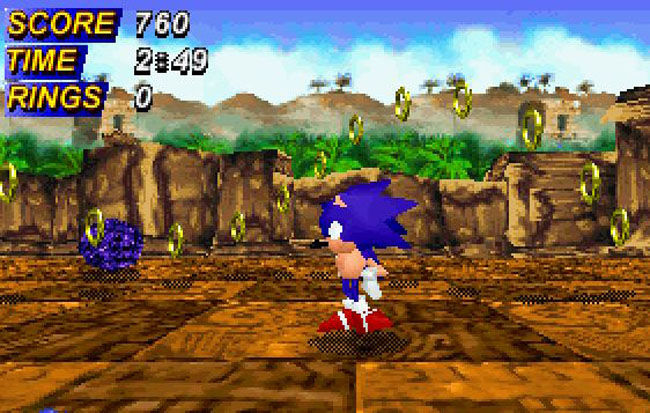
The canned Sonic X-treme
Regrettably, it would appear that the freedom and versatility of modern 3D gaming has tripped up the Sonic franchise along the way, with Sega confused as to what Sonic should do with that extra dimension. For some, releases such as 2005’s Sonic Rush - a DS success, due to its similarity to the original 2D releases - merely confirmed what they had been thinking for a while: isn’t Sonic actually a better game in two dimensions anyway?
Well, if recent form is anything to go by, perhaps not. Sonic Colors (2010) turned out to be the most accomplished 3D platformer yet, while Sonic and All-Stars Racing Transformed has proved itself to be a most respectable 3D racer. Meanwhile, both episodes of Sonic 4, developed to appease those hankering back to the early days, were of good quality, though not brilliant; they failed to hammer down 2D play as the definitive style for Sonic. So I guess the jury’s still out.
It never struck me that the Sonic franchise had the most engaging plotlines or characters, save the main protagonist himself, yet here we are over 20 years later with a huge range of spin-off games, not to mention the various animations and comics based on the character. Kids clearly love him to bits and he’s here to stay.
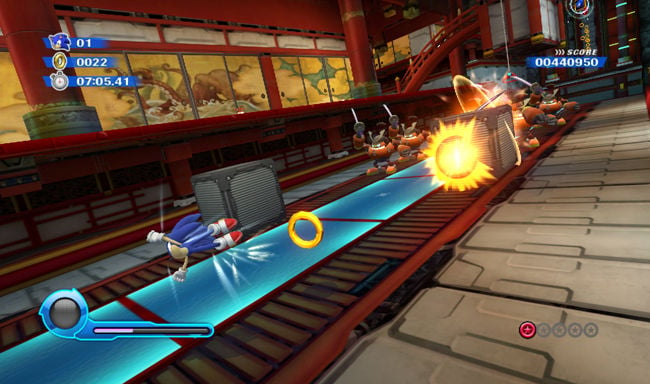
Three dimensional: Sonic Colors
Sonic has kept Sega buoyant, even through tricky times, and now the company is without hardware of its own to promote, the blue spiky one is most certainly one of their key assets. Yet it could have been an entirely different story: without the quality and success of those first few Sonic games, it’s quite possible to imagine Sega and Sonic sadly consigned to the history books by now. ®